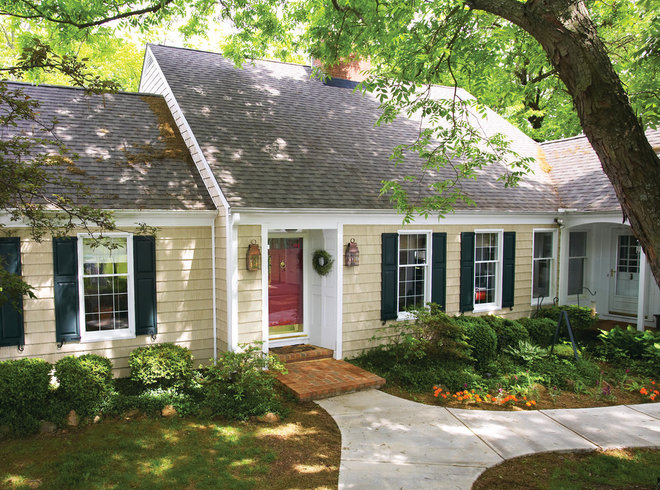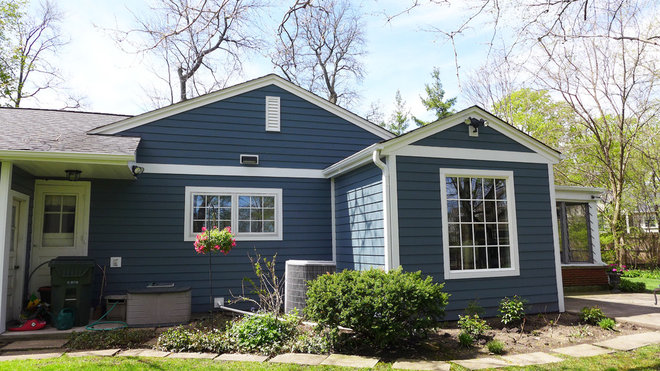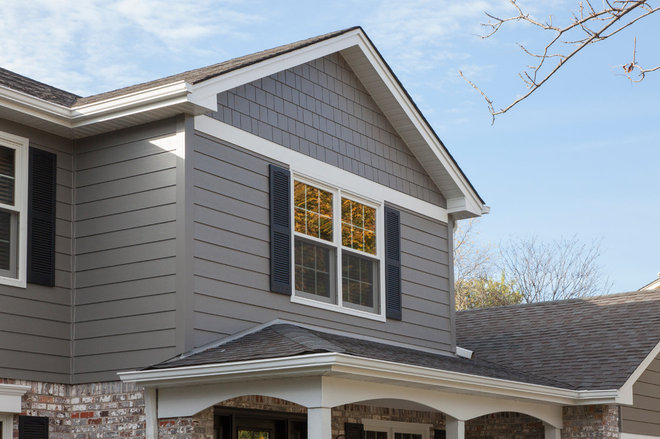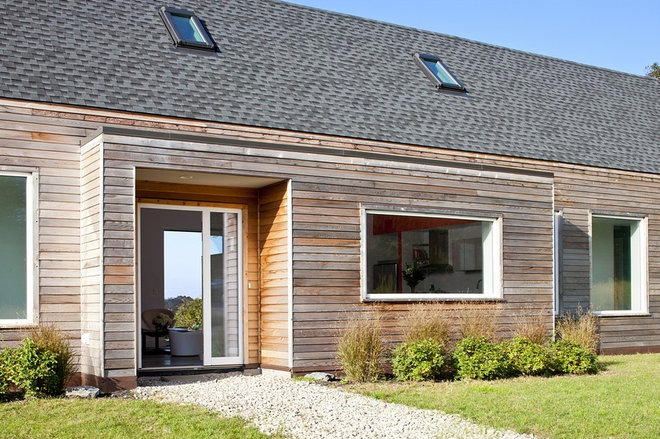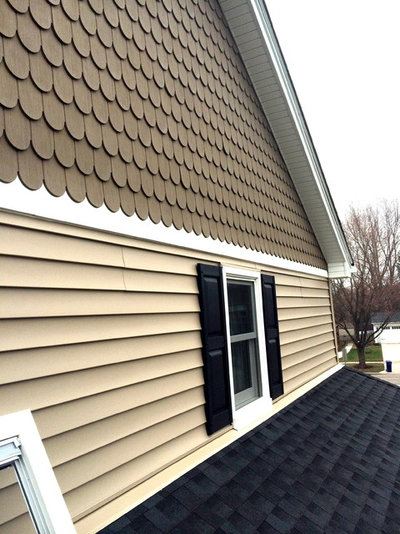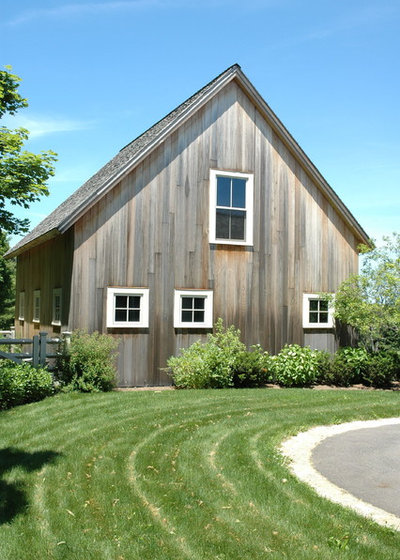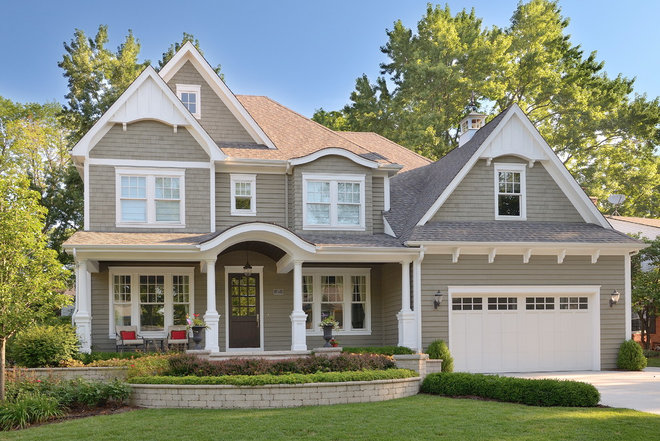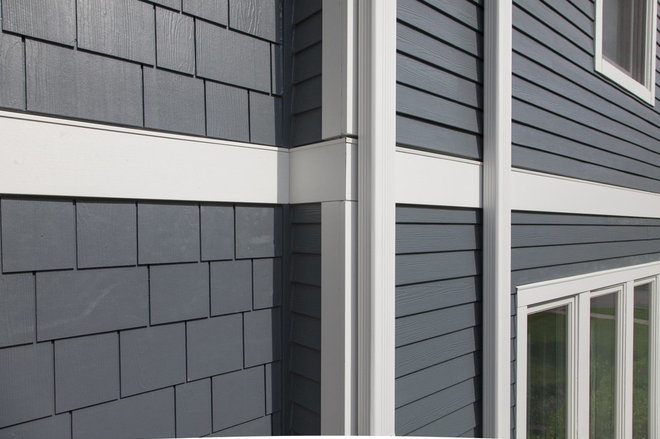Reasons for Changing Siding
There are two main reasons for updating your siding: damage or deterioration to existing siding, or just the desire to change the look of your home.
Tara Dawn of Opal Enterprises says the majority of her clients fall into the first category. Maybe they’ve owned or bought a home that’s 30 years old, and the siding is so deteriorated that they’re now worried about water infiltration.
Exterior siding is exposed to the elements, so it’s not going to last forever. Fading from sunshine, damage from storms or the aftermath of your lead-footed teenager ramming into the side of your house — there are many things that can take a toll on siding.
If your siding is damaged in just one spot, say on the side of the house from a car bump or a small fire, you might be considering replacing just the siding on that area. But it’s not as easy as it sounds.
Many companies don’t do patchwork because it’s a liability for the contractor, Dawn says. Plus, it’s very difficult to match any existing siding due to fading and availability of the exact product, assuming you know what the product is and where to find it. Few contractors leave details about the siding product name and model number in the hands of homeowners to pass along.
Most times it’s just not cost-effective for siding companies to spend time trying to determine your current siding product, tracking down the exact same profile and trying to color match it. “It can be done, it’s just difficult,” Dawn says. “None of us want mixed-match houses.”
Many home professionals recommend that if you do have some damage to your siding and it’s not causing leaks or water damage, you should wait until you can replace all the siding on your home.
Most products are designed to mimic real cedar siding. Every product has its pros and cons, and it’s important that you do your own research before you reach out to siding professionals or a local contractor.
Often, siding pros deal in just one material and want to sell you on that product. Contractors might be familiar with installing only a certain material and will try to persuade you to go with a different product. So study up and make the right choice for yourself.
Vinyl. This is a plastic material that comes in a variety of thicknesses and qualities.
Pros: Vinyl comes in lots of colors and textures. It’s affordable and allows for the most insulation behind it. The product comes with a lifetime warranty. (Dawn cautions: It’s not your lifetime, but the lifetime of the product, which is a bit ambiguous.) It’s also treated chemically with insect repellents and rot resistance. Plus, installation is quick.
Cons: Dawn says she always tells homeowners that “plastic will do what plastic will do — warp, bend, crack, fade.” This product typically only lasts 10 to 15 years. It’s not fire resistant, either. “If you put your barbecue next to it, you could have melted siding,” she says.
Time to install: Two to three days
Cost: $9 per square foot, including labor
Composite board. This product is made from recycled wood pulp pressed together with glues and adhesives.
Pros: Composite comes in any color you want. Pick any paint color from any paint store, and the material comes prefinished in your color choice. It’s also paintable and relatively environmentally friendly due to its recycled nature. Installation is easy, so contractors like it. It’s also treated chemically with insect repellents and rot resistance.
Cons: You have to repaint composite every three to five years. It’s not fire resistant, but very combustible. Composite products can have delamination problems, meaning that water absorption can swell and break apart the pressed wood chip layers. Sometimes the material can arrive sloppily finished, such as paint missing on the edges. “If anything isn’t painted, that means it’s not protected,” Dawn says.
Time to install: Five to seven days
Cost: $10 to $11 per square foot, including labor
Pros: It’s durable, fire resistant and hail resistant. Insurance companies might give you a small discount for installing it. It’s also treated chemically with insect repellent and rot resistance. It’s paintable and comes prefinished from the factory with many bold color options.
Cons: It’s very heavy and takes a long time to install, which means labor is expensive. Some contractors don’t like working with it.
Time to install: 10 to 12 days
Cost: $12 to $13 per square foot, including labor
Pros: This is the real deal. Cedar looks beautiful. It’s also pretty easy to replace, as you can just go down to your local lumberyard and have it installed, then painted.
Cons: Cedar is really expensive and high-maintenance. It tends to have moisture, rot, insect, rodent and woodpecker issues. (Yes, woodpeckers.)
Cost: $15 to $16 per square foot, including installation
Decorative Elements
Be prepared to consider a number of decorative elements for your siding. Siding companies will go over it with you, but it helps if you come prepared — for example, by creating a Houzz ideabook with siding styles that you like.
All materials come with decorative elements meant to mimic wood. You might find you like shake-style shingles, fake stone, decorative columns, scallops, belly bands (like a belt for your home that separates paint colors from different siding portions) and more.
You can also find decorative accessories for electrical boxes, water spigots and your lights. Of course, the more decorative you get, the more you’ll pay. “Most homes get pared down to what’s affordable,” Dawn says.
If it sounds a little overwhelming, don’t worry. Your siding professional will help guide you through the selections. He or she even will come out to your home and take photographs to upload into design software that will show you what your home will look like with your new siding, color and decorative accessories.
DIY
This isn’t a normal DIY project. Dawn says it’s similar to roofing. “Only about 1 to 2 percent of people can DIY siding,” she says. And many of those are people who previously worked in the siding business.
Plus, installing certain products incorrectly can void the warranty, says Jordan Heller of Erdmann Exterior Designs.
Obstacles
Make sure you check with your homeowners association, if you have one, to make sure it doesn’t prohibit certain materials and colors.
Insurance and payment plans. If your home is insured to cover damage from storms or accidents, you may get money to cover the cost of siding repair. But insurance companies will likely only cover the cost to the damaged portion of the home, not the entire siding, so be prepared to foot the extra bill to re-side your whole house or live with a somewhat mismatched area of your house.
Heller suggests clients get insurance money first before starting the project to prevent any holdups.
Budget. Many contractors offer 12- or 24-month payments for siding so you don’t have to pay everything upfront.
Permitting
Permit requirements are up to every individual city, town or village. Most pros will pull the permit for you, but you must pay for the cost of the permit.
Best Time to Start
For many exterior siding pros, the slow season is December and January, but now is the best time to contact a company to get on its schedule for spring, which is the busy season. “Once the first sunny day hits in March, you want to be there on that list,” Heller says.
The long lead time ensures that your product can get ordered and delivered on time.


